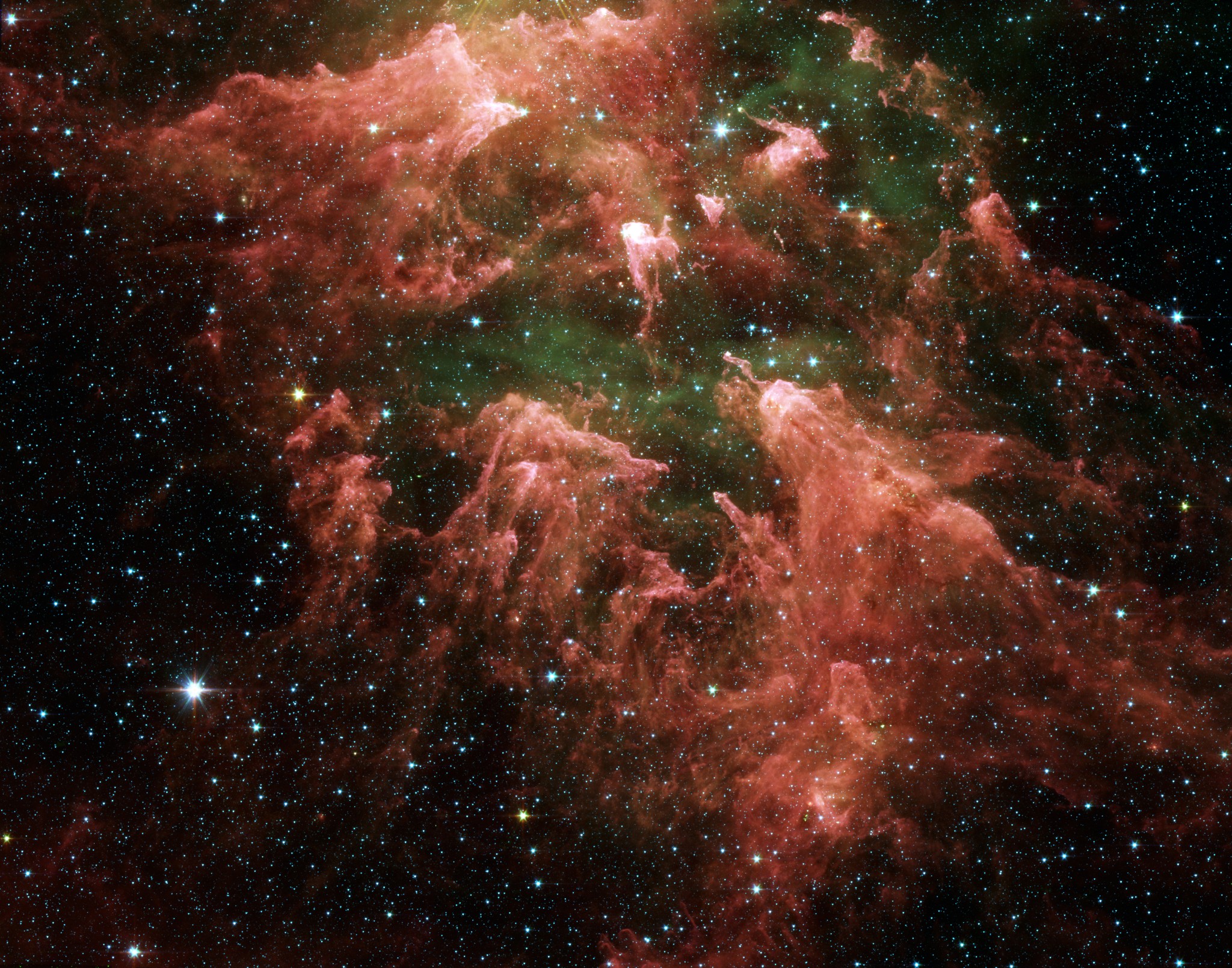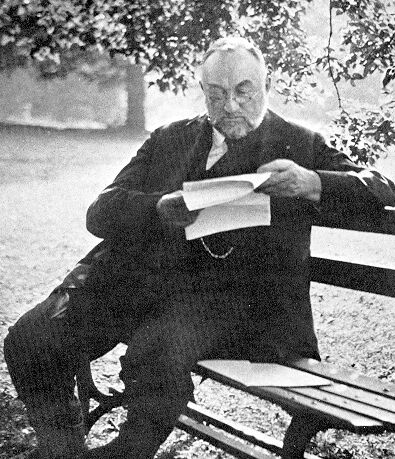 Eta Carinae, an unstable and massive star in the Milky Way, greatly affects its environment. This picture shows the South Pillar of the Carina Nebula, where regions of dust and gas are being molded by the intense wind and radiation of Eta Carinae and newborn stars. This region is nearly 10,000 light-years. This image was taken by the Space Spitzer Telescope and the image spans 200 light-years.
Eta Carinae, an unstable and massive star in the Milky Way, greatly affects its environment. This picture shows the South Pillar of the Carina Nebula, where regions of dust and gas are being molded by the intense wind and radiation of Eta Carinae and newborn stars. This region is nearly 10,000 light-years. This image was taken by the Space Spitzer Telescope and the image spans 200 light-years.
Friday, March 14, 2008
3.18 Sculpting the South Pillar
 Eta Carinae, an unstable and massive star in the Milky Way, greatly affects its environment. This picture shows the South Pillar of the Carina Nebula, where regions of dust and gas are being molded by the intense wind and radiation of Eta Carinae and newborn stars. This region is nearly 10,000 light-years. This image was taken by the Space Spitzer Telescope and the image spans 200 light-years.
Eta Carinae, an unstable and massive star in the Milky Way, greatly affects its environment. This picture shows the South Pillar of the Carina Nebula, where regions of dust and gas are being molded by the intense wind and radiation of Eta Carinae and newborn stars. This region is nearly 10,000 light-years. This image was taken by the Space Spitzer Telescope and the image spans 200 light-years.
Thursday, March 13, 2008
3.17 Planetary Nebulae
http://www.cynical-c.com/archives/bloggraphics/eskimo.jpg
http://cseligman.com/text/stars/egg.jpg
http://home.att.net/~a.campanella/hubble_nebula_0828_f.jpg
http://science.nationalgeographic.com/staticfiles/NGS/Shared/StaticFiles
/Science/Images/Content/supernova-chaos-remnant-n-63a-sw.jpg
This is a Black Hole, for good measure:
http://science.nationalgeographic.com/staticfiles/NGS/Shared/StaticFiles
/Science/Images/Content/perseus-black-hole-perseus-sw.jpg
Friday, March 7, 2008
3.16 The Cat Paw Nebula
 Visible in Scorpius, the Cat Paw Nebula is an impressive emission nebula. Its red color originates from an abundance of ionized Hydrogen. The nebula is nearly 5,500 light-years away. In the past million years, stars have been formed that are nearly a million times larger than the Sun. The Cat Paw Nebula is alternatively known as the Bear Claw Nebula as well as NGC 6334. This photo is an image of the end of the Cat Paw Nebula taken from a telescope in Chile.
Visible in Scorpius, the Cat Paw Nebula is an impressive emission nebula. Its red color originates from an abundance of ionized Hydrogen. The nebula is nearly 5,500 light-years away. In the past million years, stars have been formed that are nearly a million times larger than the Sun. The Cat Paw Nebula is alternatively known as the Bear Claw Nebula as well as NGC 6334. This photo is an image of the end of the Cat Paw Nebula taken from a telescope in Chile.
Thursday, March 6, 2008
3.14 Edward Pickering Biography
Edward Charles Pickering
Edward Charles Pickering was an American astronomer and physicist who indelibly left a lasting mark on both fields both in the United States and abroad. Pickering was born on July 19, 1946 in Boston, Massachusetts where he spent nearly all of his childhood. He attended Boston Latin School and then went on to receive his B.S. degree at Harvard University, graduating in 1865. In 1867, Pickering became a professor at the Massachusetts Institute of Technology (MIT) and held that position for ten years. At MIT, Pickering helped to establish the first U.S. laboratory in which student were required to use laboratory instruments to make measurements. Pickering left MIT to become the professor of astronomy at Harvard as well as the director of the Harvard observatory. That same year he co-founded the Appalachian Mountain Club, one of the United States’ oldest outdoor groups. Pickering was the director of the observatory for forty-two years during which time he and his staff observed more than forty-five thousand stars. The observatory under his direction was also able to make great leaps in the gathering of stellar spectra by means of photography. Pickering was also able to hire several women in his observatory due to several donations from Henry Draper’s widow. They included Annie Jump Cannon, Henrietta S. Leavitt, Williamina P. Fleming, and Antonia Maury. These women became popularly known in the scientific community as “Pickering’s Harem.” Despite this nickname, many of these women made important discoveries in the field. The observatory also produced the Henry Draper Catalogue, which contained objective prism spectra from nearly a million stars according to Annie J. Cannon’s “Harvard Sequence.”
Pickering also introduced the use of the meridian photometer to the observatory, which utilized a calcite prism to juxtapose the image of a star with one of a designated group of north polar stars to compare their brightness. Much of the data collected from this device was used to compile another catalogue entitled Harvard Photometry. He also established an observatory in Arequipa, Peru in 1891, where he collected data of southern stars that he combined with the data collected in Massachusetts. From this data, he published the first all-sky photographic map. Pickering and Hermann Carl Vogel both independently discovered the first spectroscopic binary stars. In addition, Pickering discovered a new series of spectral lines that were actually due to ionized Helium. In 1911, Pickering also co-founded the American Association of Variable Star Observers with William Olcott, where he encouraged many amateur astronomers. Edward Pickering died at Harvard on February 3rd, 1919. Pickering also won several awards during his lifetime. These include the Bruce Medal, the Royal Astronomical Society’s Gold Medal, the Henry Draper Medal, and the Order Pour le Merite for Arts and Sciences. Furthermore, Pickering held several leadership positions in his field, including President of the American Astronomical Society and the American Association for the Advancement of Science. Because of Pickering’s contributions to Astronomy, many objects are named for him. The Pickering crater on the Moon is named both for him and his brother William Pickering. There is also a Pickering crate on Mars in his honor as well as minor planet 784, Pickeringia.
Sources were previously listed.


